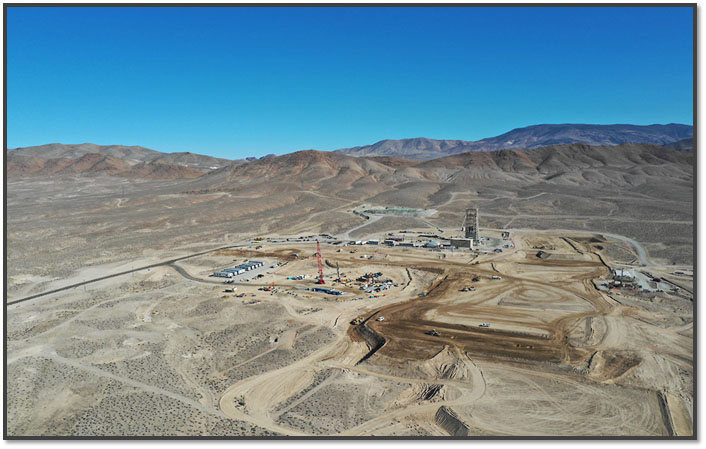Can Coal Endure Competition, Anti-Carbon Lobby?
Source: Zacks Equity Research (11/17/14)
"The switch in the U.S. Senate recently following the mid-term elections is beneficial for the industry, as the incoming majority remains opposed to the EPA's tough regulatory regime. But it's hard to know to what extent they can help the industry given the existing rules/statues in place already."

Coal production in the U.S. is expected to increase 0.3% per year til 2040 according to a recent report from the U.S. Energy Information Administration (EIA). However, the Clean Power Plan proposed by the U.S. Environmental Protection Agency (EPA)—which calls for a cutback in carbon emissions during power generation by 30% by 2030 from 2005 levels—could see lower demand for coal in the U.S. going forward.
In response to the anti-carbon drive, utility operators are shutting down coal-based power plants and are directing fresh investments towards constructing natural gas power plants and adding more renewables.
A recent release from Arch Coal Inc. (ACI - Analyst Report) echoes the same negative sentiment for thermal coal going forward. The company expects 60 gigawatt (GW) of coal-based power plants to go offline by 2018 of which 20 GW will close operation in 2015. This will lower the gross demand for thermal coal by 25 million tons.
Discussed below are the severe headwinds that the coal industry has to contend with.
Environmental Legislation: Coal has been losing its importance as a fuel source over the last few years, particularly in the U.S., vis-à-vis other energy sources that have a lesser negative impact on the environment. Concerns over the emission of greenhouse gases and global climate change have resulted in the formulation of new legislations and policies which emphasize on the use of environment- friendly fuel sources, particularly in the power sector.
This has considerably slowed the expansion of coal-fired capacity in the power sector, with utility companies now building new natural gas-fired plants and resorting to alternative sources of energy generation like wind, solar and hydro power.
Per a report from Industrial Info Resources, active coal mining projects in the U.S. have declined 39% from 2011 levels. The report says that such projects declined to $7.5 billion in 2013 from $12.3 billion in 2011.
As the result of the increasing regulatory pressure, large coal-based power producers in the U.S. like American Electric Power (AEP - Analyst Report) and Southern Company (SO - Analyst Report) are lowering their carbon footprint by shutting down old coal-based power plants and replenishing the loss in production through other eco-friendly means. The switch in the U.S. Senate recently following the mid-term elections is beneficial for the industry, as the incoming majority remains opposed to the EPA's tough regulatory regime. But it's hard to know to what extent they can help the industry given the existing rules/statues in place already.
Natural Gas Substituting Coal: A major substitute for coal in energy generation is another fossil fuel – natural gas. Coal is being dumped in favor of natural gas, which due to extensive exploration and production and a shale gas boom in onshore U.S. is seeing significantly lower prices than in the past.
Natural gas is usually an attractive choice for new generating plants because of its relative fuel efficiency, low emissions, quick construction timelines and low capital costs. This trend is encouraging power generators to not only convert their existing plants to gas-fired ones but to build new units.
Electric generation through gas-fired plants is likely to become more competitive over the coming years given its abundant domestic availability and the threat of regulation hanging over the coal mining industry. As per EIA’s reports, natural gas consumption is expected to average 72.5 Bcf/d in 2014, an increase of 1.6% from 2013, with the industrial sector supporting the growth. In 2015, total natural gas consumption will increase 0.3%, as continued industrial sector growth and higher electric power sector consumption offset lower residential and commercial consumption.
As per the EIA, natural gas-based electricity generation in the U.S. will overtake coal-based generation in 2035. The projection assumes the retirement of coal-fired units and lower prices for natural gas going forward.
Exelon Corporation (EXC - Analyst Report) recently announced that its unit Exelon Generation will expand its natural gas-based power generation capacity by 2,000 MW. Duke Energy Corporation (DUK - Analyst Report) announced its intent to add nearly 2,930 MW of natural gas-based power units going forward.
Competition from Alternative Energy Sources: Apart from natural gas, the coal industry has been losing a major share of its electric generation demand to renewable sources of energy.
Production of power from renewable sources has also been supported by most states the U.S. At present there is no national consensus regarding the percentage of energy to be generated from renewable sources.
Undoubtedly, state legislators are giving more emphasis to produce power from renewables. At present, 30 U.S. states and the District of Columbia have enforceable renewable portfolio standards or other renewable generation policies. These policies were designed to spread awareness and encourage the power generators to produce more from renewable sources.
The share of renewable fuels (including conventional hydro) in energy generation is projected to grow from 10% in 2010 to 16% in 2040, as per the EIA’s long-term outlook. High quality solar modules produced by First Solar Inc. (FSLR - Analyst Report) and SolarCity Corporation (SCTY - Snapshot Report) among others will find wider acceptance given the rising concerns regarding emissions.
To Sum Up
In “Would You Add Coal to Your Portfolio?” we focused on the conditions which are expected to drive the industry forward.
Given the increasing regulatory pressure on coal, the U.S. miners might look forward to exporting larger volumes of coal to Asia. China is among the largest importers of both thermal and metallurgical coal.
However, China has reintroduced tariffs on coal imports to safeguard the interest of domestic coal producers. China levied a 3% tariff on coking coal and a 6% tariff on thermal coal imports, which could impact the U.S. exporters.
In response to the anti-carbon drive, utility operators are shutting down coal-based power plants and are directing fresh investments towards constructing natural gas power plants and adding more renewables.
A recent release from Arch Coal Inc. (ACI - Analyst Report) echoes the same negative sentiment for thermal coal going forward. The company expects 60 gigawatt (GW) of coal-based power plants to go offline by 2018 of which 20 GW will close operation in 2015. This will lower the gross demand for thermal coal by 25 million tons.
Discussed below are the severe headwinds that the coal industry has to contend with.
Environmental Legislation: Coal has been losing its importance as a fuel source over the last few years, particularly in the U.S., vis-à-vis other energy sources that have a lesser negative impact on the environment. Concerns over the emission of greenhouse gases and global climate change have resulted in the formulation of new legislations and policies which emphasize on the use of environment- friendly fuel sources, particularly in the power sector.
This has considerably slowed the expansion of coal-fired capacity in the power sector, with utility companies now building new natural gas-fired plants and resorting to alternative sources of energy generation like wind, solar and hydro power.
Per a report from Industrial Info Resources, active coal mining projects in the U.S. have declined 39% from 2011 levels. The report says that such projects declined to $7.5 billion in 2013 from $12.3 billion in 2011.
As the result of the increasing regulatory pressure, large coal-based power producers in the U.S. like American Electric Power (AEP - Analyst Report) and Southern Company (SO - Analyst Report) are lowering their carbon footprint by shutting down old coal-based power plants and replenishing the loss in production through other eco-friendly means. The switch in the U.S. Senate recently following the mid-term elections is beneficial for the industry, as the incoming majority remains opposed to the EPA's tough regulatory regime. But it's hard to know to what extent they can help the industry given the existing rules/statues in place already.
Natural Gas Substituting Coal: A major substitute for coal in energy generation is another fossil fuel – natural gas. Coal is being dumped in favor of natural gas, which due to extensive exploration and production and a shale gas boom in onshore U.S. is seeing significantly lower prices than in the past.
Natural gas is usually an attractive choice for new generating plants because of its relative fuel efficiency, low emissions, quick construction timelines and low capital costs. This trend is encouraging power generators to not only convert their existing plants to gas-fired ones but to build new units.
Electric generation through gas-fired plants is likely to become more competitive over the coming years given its abundant domestic availability and the threat of regulation hanging over the coal mining industry. As per EIA’s reports, natural gas consumption is expected to average 72.5 Bcf/d in 2014, an increase of 1.6% from 2013, with the industrial sector supporting the growth. In 2015, total natural gas consumption will increase 0.3%, as continued industrial sector growth and higher electric power sector consumption offset lower residential and commercial consumption.
As per the EIA, natural gas-based electricity generation in the U.S. will overtake coal-based generation in 2035. The projection assumes the retirement of coal-fired units and lower prices for natural gas going forward.
Exelon Corporation (EXC - Analyst Report) recently announced that its unit Exelon Generation will expand its natural gas-based power generation capacity by 2,000 MW. Duke Energy Corporation (DUK - Analyst Report) announced its intent to add nearly 2,930 MW of natural gas-based power units going forward.
Competition from Alternative Energy Sources: Apart from natural gas, the coal industry has been losing a major share of its electric generation demand to renewable sources of energy.
Production of power from renewable sources has also been supported by most states the U.S. At present there is no national consensus regarding the percentage of energy to be generated from renewable sources.
Undoubtedly, state legislators are giving more emphasis to produce power from renewables. At present, 30 U.S. states and the District of Columbia have enforceable renewable portfolio standards or other renewable generation policies. These policies were designed to spread awareness and encourage the power generators to produce more from renewable sources.
The share of renewable fuels (including conventional hydro) in energy generation is projected to grow from 10% in 2010 to 16% in 2040, as per the EIA’s long-term outlook. High quality solar modules produced by First Solar Inc. (FSLR - Analyst Report) and SolarCity Corporation (SCTY - Snapshot Report) among others will find wider acceptance given the rising concerns regarding emissions.
To Sum Up
In “Would You Add Coal to Your Portfolio?” we focused on the conditions which are expected to drive the industry forward.
Given the increasing regulatory pressure on coal, the U.S. miners might look forward to exporting larger volumes of coal to Asia. China is among the largest importers of both thermal and metallurgical coal.
However, China has reintroduced tariffs on coal imports to safeguard the interest of domestic coal producers. China levied a 3% tariff on coking coal and a 6% tariff on thermal coal imports, which could impact the U.S. exporters.



























































